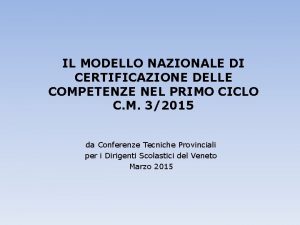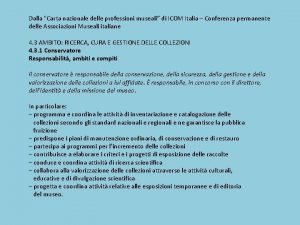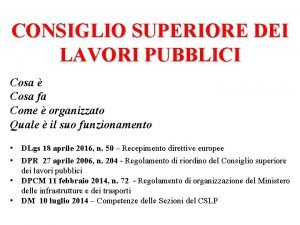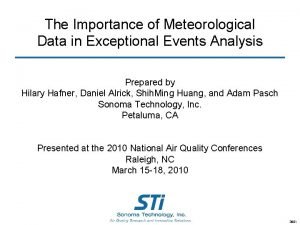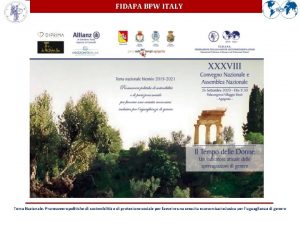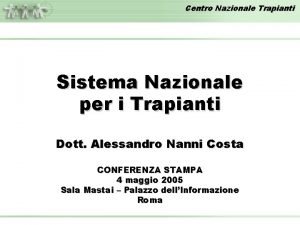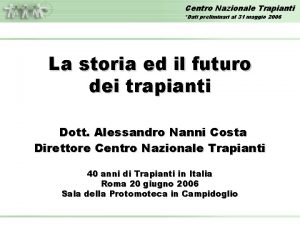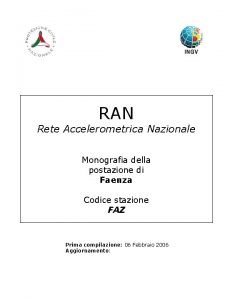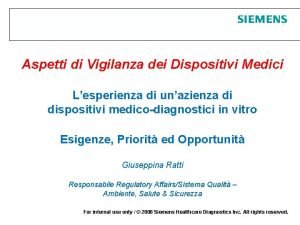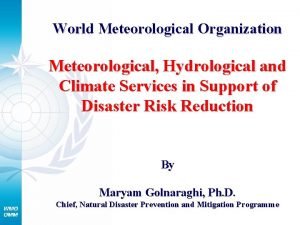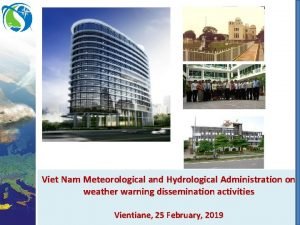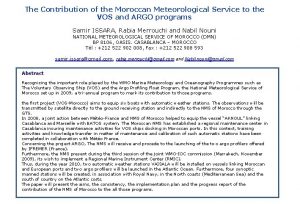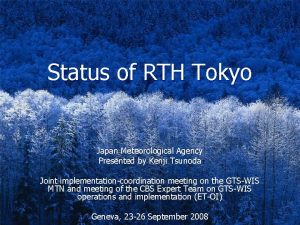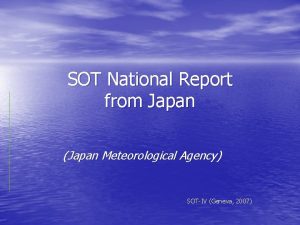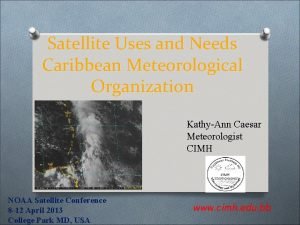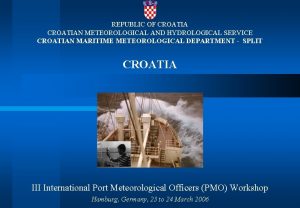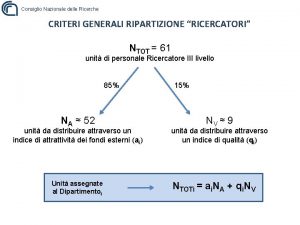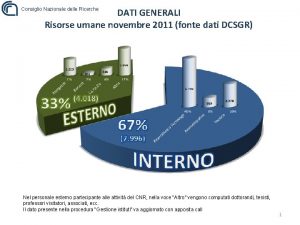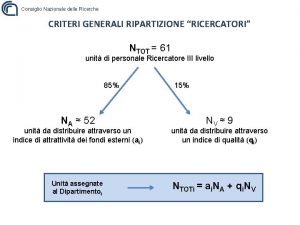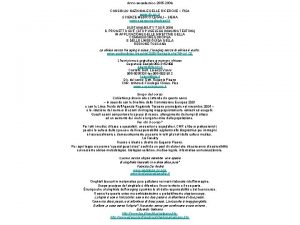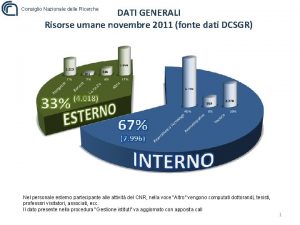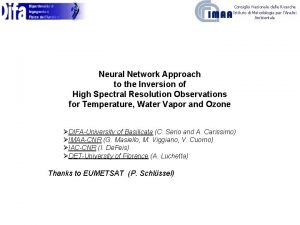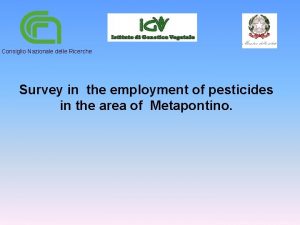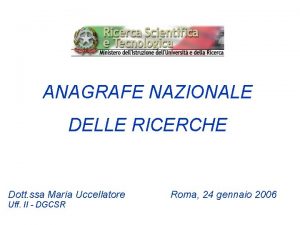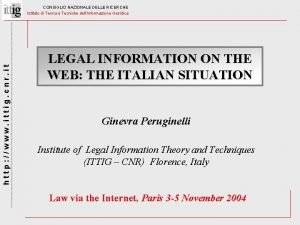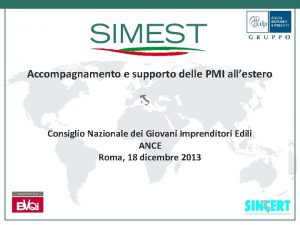Consiglio Nazionale delle Ricerche Importance of Meteorological Information































![Mass streamfunction [1 E 10 kg/s] (NCEP/NCAR Reanalysis 1971 -2002) Hadley Cell Hadley, Ferrel Mass streamfunction [1 E 10 kg/s] (NCEP/NCAR Reanalysis 1971 -2002) Hadley Cell Hadley, Ferrel](https://slidetodoc.com/presentation_image/30b05693d12ce9da756a2d4dba53262c/image-32.jpg)












- Slides: 44

Consiglio Nazionale delle Ricerche Importance of Meteorological Information in Locust Forecasting Models WMO, Geneva, October 18, 2004 G. Maracchi and L. Genesio IBIMET-CNR

Biological cycle of desert locust Schistocerca gregaria (Forskal). Eggs hatching Hopper (5 juvenil stages) Gregary egg laying 80 eggs Solitary egg laying 90 -150 eggs migration Solitary Adult Gregary Adult swarms 3 to 5 generations per year in Africa

Recession Plague • In recession periods desert locusts concentrate in semi-arid and arid regions of Africa, near East and south-West Asia • In plague periods they expand over enormous areas covering the 20% of the total surface of the world Importance of Meteorological Information in Locust Forecasting Models WMO, Geneva, October 18, 2004 G. Maracchi and L. Genesio

A biblical plague • Pharaonic times plagues • Plagues in Europe reported in 18 th century • Twenty century plagues: 1926 -1934; 1940 -1948; 1949 -1963; 1967 -1969; 1986 -1989; 2003 -2004 • In 2004 around 4 million hectars have been infested in West Africa. The infestation extended from Sudan to Cape Vert. More severely affected countries: Mauritania, Niger, Mali and Senegal. Importance of Meteorological Information in Locust Forecasting Models WMO, Geneva, October 18, 2004 G. Maracchi and L. Genesio

Migratory movements Spring Autumn source FAO Importance of Meteorological Information in Locust Forecasting Models WMO, Geneva, October 18, 2004 G. Maracchi and L. Genesio

Importance of meteorological parameters in desert locust cycle • In the reproduction phase : soil humidity for eggs opening • In the juvenil phase (hopper) : rainfall amounts favourable for vegetation growth accelerate instar development supporting large populations of young locusts • In the migratory phase : wind driven movements Importance of Meteorological Information in Locust Forecasting Models WMO, Geneva, October 18, 2004 G. Maracchi and L. Genesio

Rainfall amounts in the reproduction phase • Are important for the hatching phase and for hopper development (vegetation growth) Importance of Meteorological Information in Locust Forecasting Models WMO, Geneva, October 18, 2004 G. Maracchi and L. Genesio

Early start of rainy season in the Sahel Favourable conditions for eggs laying and hatcing Data source Elaboration: IBIMET-CNR Importance of Meteorological Information in Locust Forecasting Models WMO, Geneva, October 18, 2004 G. Maracchi and L. Genesio

Weather driven migration • Desert locust fly with the winds over long distances: – 1954 : North-Africa to British Islands – 1988 : West-Africa to the Caribbean (5000 km) Importance of Meteorological Information in Locust Forecasting Models WMO, Geneva, October 18, 2004 G. Maracchi and L. Genesio

Small infestations in Mediterranean Europe were reported in 2003 and 2004 summer associated with favourable winds Skyways (Vertical Wind Anomaly) 2003 2004 Importance of Meteorological Information in Locust Forecasting Models WMO, Geneva, October 18, 2004 G. Maracchi and L. Genesio

Skyways in May 2004 Importance of Meteorological Information in Locust Forecasting Models WMO, Geneva, October 18, 2004 G. Maracchi and L. Genesio

Climate sensitiveness of locust Climatic caracteristic of peak years • Favourable winds direction and persistence • High rainfall amounts at the beginning and at the end of the cropping season in Sub-saharian Africa (start and lenght of cropping season) • High rainfall amounts in Spring in North Africa Importance of Meteorological Information in Locust Forecasting Models WMO, Geneva, October 18, 2004 G. Maracchi and L. Genesio

Climate sensitiveness of locust The high inter annual variability in locust infestation is mainly due to the high climate sensitiveness of their reproduction and diffusion phases Importance of Meteorological Information in Locust Forecasting Models WMO, Geneva, October 18, 2004 G. Maracchi and L. Genesio

Parameters for predictability in different lifecycle phases • Reproduction phase: – Soil humidity – Vegetation development – Lenght of the cropping season in the Sahel • Migration phase: – Wind – Vegetation Importance of Meteorological Information in Locust Forecasting Models WMO, Geneva, October 18, 2004 G. Maracchi and L. Genesio

Time scales and tools for prediction • Short term forecasting • Medium term predictions • Long term predictions Importance of Meteorological Information in Locust Forecasting Models WMO, Geneva, October 18, 2004 G. Maracchi and L. Genesio

Short term monitoring The continuous monitoring of rain and vegetation conditions provide important information for monitoring Desert Locust habitats and forecasting locust development • Monitoring of NDVI anomaly (NOAA, Spot Vegetation) • Rainfall estimates (Meteosat) Importance of Meteorological Information in Locust Forecasting Models WMO, Geneva, October 18, 2004 G. Maracchi and L. Genesio

Seasonal vegetation development in southern Mali – AP 3 A Project Importance of Meteorological Information in Locust Forecasting Models WMO, Geneva, October 18, 2004 G. Maracchi and L. Genesio

Short term monitoring NDVI anomaly over north-Africa and sahel in 2004 Source NASA Importance of Meteorological Information in Locust Forecasting Models WMO, Geneva, October 18, 2004 G. Maracchi and L. Genesio

Short term monitoring HOWI zone 3 (Mauritania) Humidity anomaly in the early season Importance of Meteorological Information in Locust Forecasting Models WMO, Geneva, October 18, 2004 G. Maracchi and L. Genesio

Short term monitoring Rainfall estimates from satellite Importance of Meteorological Information in Locust Forecasting Models WMO, Geneva, October 18, 2004 G. Maracchi and L. Genesio

Short term monitoring 6 hours rainfall estimates from satellite April 29, 2004, 06 h 00 April 29, 2004, 12 h 00

Short term monitoring Rainfall estimates from satellite Animation sequence every six hours Oct 13 -15, 2004 www. ibimet. cnr. it/Case/sahel/ Importance of Meteorological Information in Locust Forecasting Models WMO, Geneva, October 18, 2004 G. Maracchi and L. Genesio

Short term monitoring Rainfall estimates from NWM Importance of Meteorological Information in Locust Forecasting Models WMO, Geneva, October 18, 2004 G. Maracchi and L. Genesio

Rainfall estimates from NWM (96 hours forecasting)

Medium term predictions Crop season forecasting Risk Zones ZAR (AGRHYMET) Importance of Meteorological Information in Locust Forecasting Models WMO, Geneva, October 18, 2004 G. Maracchi and L. Genesio

Medium term predictions Importance of Meteorological Information in Locust Forecasting Models WMO, Geneva, October 18, 2004 G. Maracchi and L. Genesio

Medium term predictions Importance of Meteorological Information in Locust Forecasting Models WMO, Geneva, October 18, 2004 G. Maracchi and L. Genesio

Medium term predictions Importance of Meteorological Information in Locust Forecasting Models WMO, Geneva, October 18, 2004 G. Maracchi and L. Genesio

Long term prediction Seasonal forecasting: • SST • Geopotential height • ITCZ • HOWI Hydrological Onset and Withdrawal Index • Previous season late rains Importance of Meteorological Information in Locust Forecasting Models WMO, Geneva, October 18, 2004 G. Maracchi and L. Genesio

Sea Surface Temperature Importance of Meteorological Information in Locust Forecasting Models WMO, Geneva, October 18, 2004 G. Maracchi and L. Genesio

Geopotential Anomaly Importance of Meteorological Information in Locust Forecasting Models WMO, Geneva, October 18, 2004 G. Maracchi and L. Genesio
![Mass streamfunction 1 E 10 kgs NCEPNCAR Reanalysis 1971 2002 Hadley Cell Hadley Ferrel Mass streamfunction [1 E 10 kg/s] (NCEP/NCAR Reanalysis 1971 -2002) Hadley Cell Hadley, Ferrel](https://slidetodoc.com/presentation_image/30b05693d12ce9da756a2d4dba53262c/image-32.jpg)
Mass streamfunction [1 E 10 kg/s] (NCEP/NCAR Reanalysis 1971 -2002) Hadley Cell Hadley, Ferrel and polar cell Changes of Hadley cells affect the descending branch of ITCZ

Seasonal migration of descending branches of Hadley cell Seasonal migration of ITCZ follows sun declination Importance of Meteorological Information in Locust Forecasting Models WMO, Geneva, October 18, 2004 G. Maracchi and L. Genesio

Importance of Meteorological Information in Locust Forecasting Models WMO, Geneva, October 18, 2004 G. Maracchi and L. Genesio

Importance of Meteorological Information in Locust Forecasting Models WMO, Geneva, October 18, 2004 G. Maracchi and L. Genesio

Objectives for a meteorological warning systems for locust control (Me. Wa. LCo) • To optimize actions to fight infestations: – On time pesticide availability – Avoiding of accumulation of potentially obsolete pesticide stocks – Planning of Airplanes campains • To provide information for the Food crisis prevention process • To provide an assessment of potential impact on food security Importance of Meteorological Information in Locust Forecasting Models WMO, Geneva, October 18, 2004 G. Maracchi and L. Genesio

The food crisis prevention process

The food crisis prevention process: Regional crisis Scale of event (frequency) Regional scale famine (1 year every 10) Potentially affected population Million of inhabitants Impact Survival depends on food aid and on International Organisations Information and actions May June July Aug PRESAO Warning ITCZ warning and international mobilisation ZAR, SISP Prediction, terrain missions to identify the dimension of the crisis; Logistical planning for food aid Identification of vulnerable areas; Stock distribution Crisis prevention management Importance of Meteorological Information in Locust Forecasting Models WMO, Geneva, October 18, 2004 G. Maracchi and L. Genesio

Impact assessment The impact of outbreaks must be evaluated in function of the vulnerability context of the affected territory Importance of Meteorological Information in Locust Forecasting Models WMO, Geneva, October 18, 2004 G. Maracchi and L. Genesio

Importance of Meteorological Information in Locust Forecasting Models WMO, Geneva, October 18, 2004 G. Maracchi and L. Genesio

Information flow for an information system for locust control Choc Start of locust outbreaks Agricultural campaign monitoring Identification of vulnerable Monitoring of zones and groups impacts (regional/national/local) Production of scenarios Production/diffusion of information Control actions Decision making Importance of Meteorological Information in Locust Forecasting Models WMO, Geneva, October 18, 2004 G. Maracchi and L. Genesio

Availability operational tools • Many decision support systems for food security already provides operational imputs that can be useful for locust monitoring • The “convergence of evidence” methodology can be applied to locust early warning Importance of Meteorological Information in Locust Forecasting Models WMO, Geneva, October 18, 2004 G. Maracchi and L. Genesio

Climate changes and locust changes NDVI trends 1982 -2000 - first decade of May Data NOAA-AVHRR – elaboration IBIMET CNR Importance of Meteorological Information in Locust Forecasting Models WMO, Geneva, October 18, 2004 G. Maracchi and L. Genesio

Conclusions The Locust Control process needs operational tools over different periods of the year: - Early seasonal prediction - Crop season monitoring (start and lenght) - Rainfall estimation from satellite - Rainfall estimation from NWM - Biomasse estimation - Impact matrix assessment All these tools are developed by IBIMET CNR in the framework of Me. Wa. LCo Pilot Project Importance of Meteorological Information in Locust Forecasting Models WMO, Geneva, October 18, 2004 G. Maracchi and L. Genesio
 Modello nazionale di certificazione delle competenze
Modello nazionale di certificazione delle competenze Carta delle professioni museali
Carta delle professioni museali Galleria nazionale delle marche
Galleria nazionale delle marche Come fare una parafrasi di un testo epico
Come fare una parafrasi di un testo epico Lextel pec rinnovo
Lextel pec rinnovo Ezequiel consiglio
Ezequiel consiglio Consiglio superiore dei lavori pubblici
Consiglio superiore dei lavori pubblici Importance of meteorological data
Importance of meteorological data Esperienza delle cose moderne e la lezione delle antique
Esperienza delle cose moderne e la lezione delle antique La nascita delle lingue e delle letterature romanze
La nascita delle lingue e delle letterature romanze L esperienza delle cose moderne e la lezione delle antique
L esperienza delle cose moderne e la lezione delle antique Centro nazionale trapianti
Centro nazionale trapianti Infn lab nazionale di legnaro, legnaro
Infn lab nazionale di legnaro, legnaro Tema nazionale fidapa 2021
Tema nazionale fidapa 2021 Olga
Olga Direzione nazionale antimafia organigramma
Direzione nazionale antimafia organigramma Direzione nazionale antimafia e antiterrorismo
Direzione nazionale antimafia e antiterrorismo Centro nazionale trapianti
Centro nazionale trapianti Centro nazionale trapianti
Centro nazionale trapianti Assdi nazionale
Assdi nazionale Pnsd schema
Pnsd schema Borsa continua del lavoro
Borsa continua del lavoro Consolidato mondiale
Consolidato mondiale Il reddito nazionale
Il reddito nazionale Istituto nazionale di urbanistica
Istituto nazionale di urbanistica Organigramma azienda sanitaria
Organigramma azienda sanitaria Sport in germania
Sport in germania Anbba
Anbba Registro nazionale società sportive dilettantistiche
Registro nazionale società sportive dilettantistiche Istituto gemmologico nazionale
Istituto gemmologico nazionale Inno nazionale
Inno nazionale Parafrasi inno di mameli
Parafrasi inno di mameli Festa nazionale inghilterra
Festa nazionale inghilterra Rete accelerometrica nazionale
Rete accelerometrica nazionale Rete accelerometrica nazionale
Rete accelerometrica nazionale Classificazione nazionale dei dispositivi medici
Classificazione nazionale dei dispositivi medici Classificazione cnd dispositivi medici
Classificazione cnd dispositivi medici National meteorological and hydrological services
National meteorological and hydrological services Modern earth science
Modern earth science Vietnam meteorological and hydrological administration
Vietnam meteorological and hydrological administration Morocco meteorological service
Morocco meteorological service Tokyo meteorological agency
Tokyo meteorological agency Bbxx ship
Bbxx ship Ramsdis
Ramsdis Croatian meteorological and hydrological service
Croatian meteorological and hydrological service
